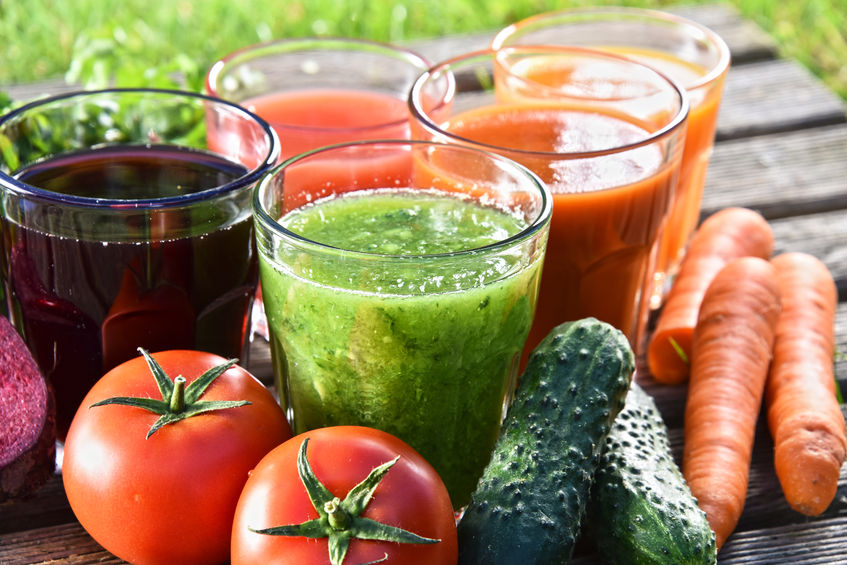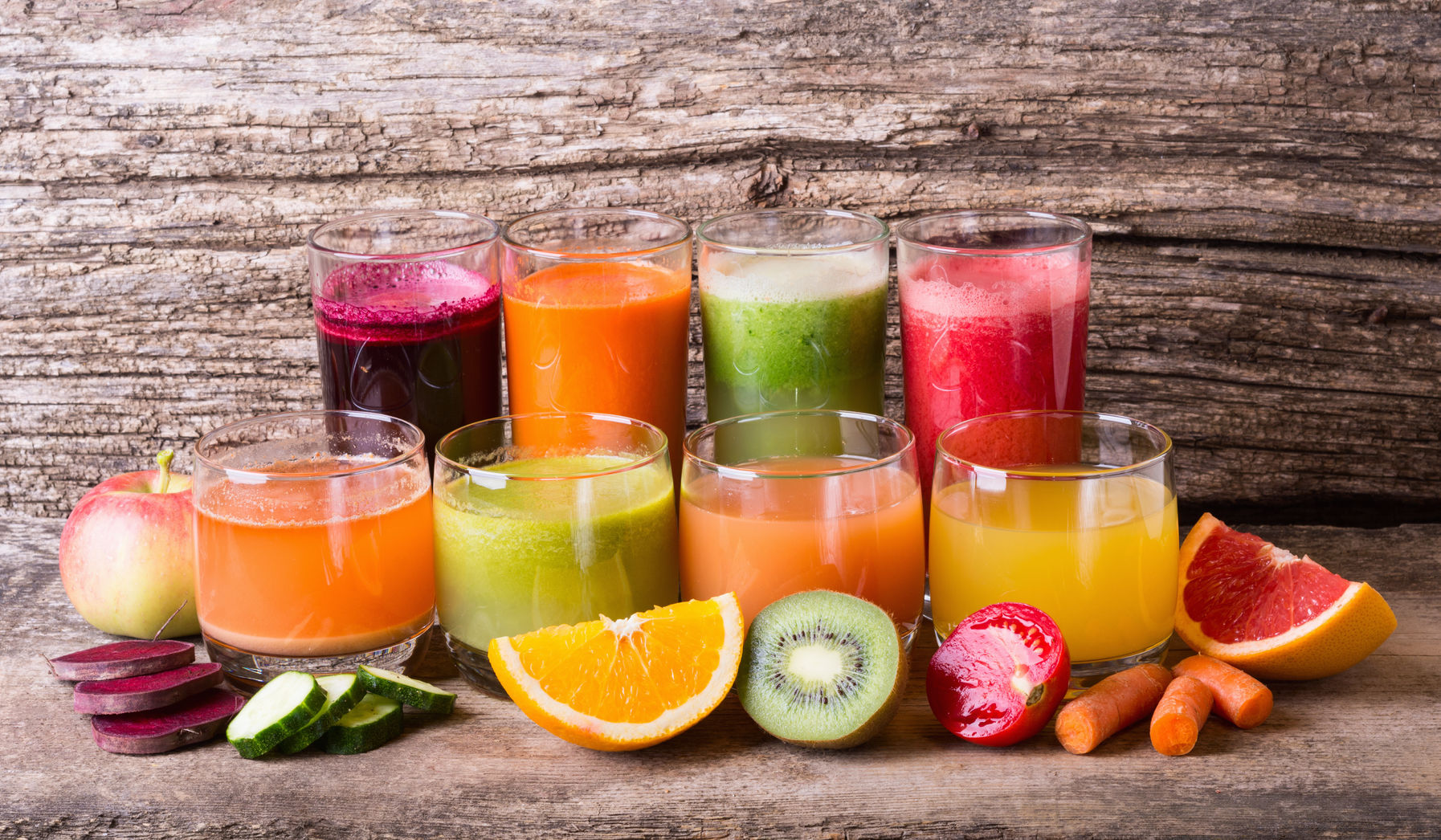More and more juice bars and health food stores are offering fresh pressed juices as a healthy and delicious option. It’s good to understand the hype so that you can fuel yourself with the healthiest juicing recipes/options out there.
What is Juicing?
Many of us know that a smoothie entails adding fruit, vegetables, protein powder and some other yummy foods into a blender and drinking as is, with nutrient-rich skin and fiber in tact. While you may see smoothies and juices side by side on a drink menu, they are a bit different from one another. Juicing actually involves the extraction of juice from fresh fruits and vegetables to create a drinkable cocktail of vitamins, minerals and phytonutrients, leaving the skin behind.
Health Benefits of Juicing
Just because the skin and fiber is removed during the juicing process doesn’t mean that it’s no longer as healthy as a smoothie. Advocates for juicing such as Joe Cross (from the documentary Fat, Sick & Nearly Dead) or Kris Carr (author of Crazy, Sexy Juice), believe it’s a fast and convenient way to get nutrients into our bodies. Drew Canole has made a career out of his passion for juicing with an active YouTube page with plenty of information on the subject. The Gerson Therapy promotes juicing as an alternative, non-toxic way to combat cancer and other chronic degenerative diseases. Other benefits of juicing include:
- Fast and easy absorption of nutrients
- Increased energy levels
- Clearer thinking ability
- Glowing eyes and skin
- Strong hair and nails
- Heightened sense of taste and smell
- Strengthened immune system
- Improved appetite control
- Provides a healthy rest for your digestive system
- Health benefits of consuming fruits and vegetables that you wouldn’t normally eat raw or whole
Tips for Successful Juicing
- Drink it fresh. Fresh juice can develop bacteria rather quickly, so to be safe, don’t wait. Vitamins and minerals can be destroyed with increased exposure to air and light, so in order to get the most from your juice, enjoy your juice right away.
- People cannot live on juice alone. Juicing is a great way to add extra nutrients and minerals into your diet, but there is typically little protein, fat, and fiber present. Your digestive system was created to work. A rest now and again is fine, but just as the mind must be kept active in order to keep it working at a high level, the same goes for bodily processes like digestion.
- Make use of the pulp. It may be an inconvenience to clean your juicer, but instead of throwing away your leftover pulp, consider putting it to good use. Pulp can be added to garden compost, or recreated into your favorite dishes using some very creative recipes.
- Be adventurous with your produce selections. One of the biggest benefits of juicing is that it allows you to consume a variety of fresh fruit and vegetables. The next time you shop, choose something you’ve never juiced before and try it out!
- Choose high quality produce. Going organic can be more expensive but it’s a health investment that pays off long-term. Check out the EWG’s Dirty Dozen list of what produce is important to purchase organic, and those that you do not! Download their app for your convenience when you’re out food shopping.
- All juices are not created equal. Vegetable juices are nutrition powerhouses. Fruit juices, although an excellent source of vitamin C, are high in naturally occurring sugars and should be consumed less often. If you’re new to juicing, try adding apples, pears, lemon, or ginger to help make your vegetable juice more palatable. Slowly work towards a 3:1 ratio – three vegetables to one piece of fruit.
- Believe it or not there are “un-juicable” items. No worries though, the list is short. Avocados and bananas are best to save for smoothies – there is actually no juice to juice from them. A fun tip, if you are having trouble getting down your green juice, whiz it in a blender with a banana to add a healthy sweetness to it. And although some peels can be juiced, citrus peels in general contain indigestible oils that aren’t complimentary to your body. You can juice the peels of smaller citrus fruits such as lemons and limes, however never more than half; otherwise, the citrus oils may overwhelm the digestive system.
Get Juicing with these Delicious Recipes

Bright Red Energy
Ingredients:
- 1 beet (with greens removed)
- 2 carrots
- 2 celery stalks
- 2 plum tomatoes
Green Goodness
Ingredients:
- 1 cup spinach or kale
- 2 celery stalks
- ½ large cucumber
- 1 apple, cored
- 1 handful parsley
- ¼ lime
- ¼ lemon
Orange Defense
Ingredients:
- ½ small pineapple, peeled and cored
- 1 large orange, peeled
- 2 large carrots
- ½ inch ginger root
- ½ lemon
Directions:
- Wash all produce well.
- Prepare produce by cutting it into pieces (small enough to fit in the top of your juicer).
- Add one ingredient to the juicer at a time.
- Pour the juice into a glass and drink right away, or refrigerate in a well-sealed container.
If you want to purchase store-bought juice instead
Homemade fresh juice is obviously the best and freshest juice available. They will save your money long-term and allow you to get creative with your juice recipes. But juicing at home may not be for everyone. Luckily, juice bars are increasingly popping up in cities and health food stores for you to purchase as needed. Just be sure to ask if they are using organic ingredients (if it’s going to be something you buy on a regular basis).
Otherwise, there are store-bought, pre-packaged raw juice which is a great option when you’re in a time crunch. Fresh juice can be purchased at health food stores or good supermarkets. If you need a healthy juice on-the-go, read labels carefully and choose words like raw, organic, and unpasteurized. Stay clear of these juice imposters that sit on the supermarket shelves for weeks. These juices often contain artificial flavors, additives, and preservatives that are added to extend the shelf life. They contain little to no nutritional benefits and often contain as much sugar as soda.



